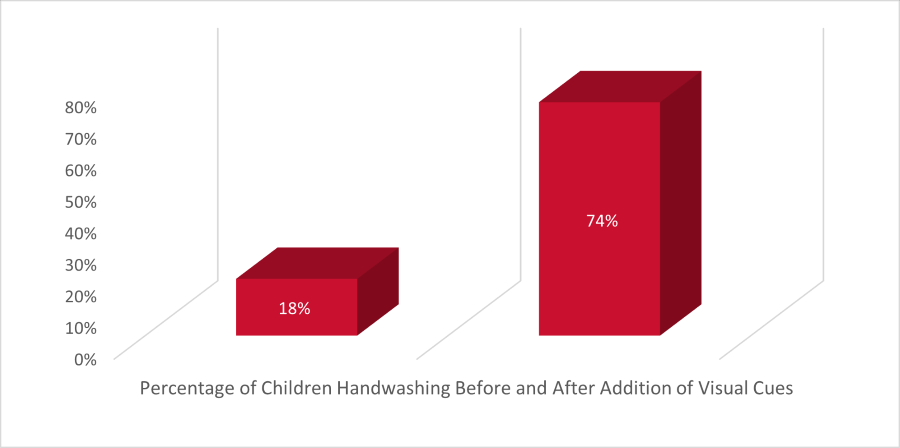Hand hygiene has been at the forefront of recent health and cleanliness discussions. A survey conducted in 2022 by the American Cleaning Institute found that 93% of Americans believe that handwashing is important when preventing illness. However, even
with recent motivators like COVID-19, people are consistently not washing their hands. What can facility managers do to encourage folks to wash their hands according to CDC guidelines? Read on to find out.
The Facts
Washing your hands reduces the potential for getting sick and spreading illness to others. Knowing this, how much of a difference does proper hand hygiene really make? The CDC handwashing guidelines recommend washing your hands before or after key
situations, such as after using the restroom and prior to preparing or eating food. When followed, these regulations offer the following benefits:
- 1 in 3 diarrheal illnesses are prevented
- Gastrointestinal illness in children is reduced by 29%-57%, increasing school attendance
- Decrease workplace illness rates, reducing absenteeism by 41%
1. Education
Educating building occupants about the importance of handwashing inspires them to wash their hands according to CDC guidelines. Signage can be placed in prime locations, such as restrooms, food prep areas, and anywhere else with a clean, accessible
sink and soap dispenser. Signage should be easy to understand, ideally with pictures illustrating the process.
Handwashing signage should highlight one of three main factors:
- Why clean hands are important for personal health – 80% of contagious diseases can be transferred by touch
- Proper handwashing steps – It is recommended that signage containing handwashing steps is placed by sinks and handwashing stations for maximum exposure
- Critical handwashing situations – The CDC suggests washing your hands after using the bathroom, before eating, and after blowing your nose, coughing, or sneezing
For a downloadable, printable flyer explaining handwashing procedures, please click here.
Stay Informed: Take Clean Further with Betco
Subscribe to Betco emails to join thousands of other industry professionals and get the most helpful blog posts, the latest news, new product notifications, and invitations to our events conveniently in your inbox!
Yes, Sign Me Up!
2. Convenience and Appearance
Research shows that individuals are more inclined to wash their hands when restroom facilities are clean, fully functional, and organized. Ensuring soap dispensers are available at every sink and restroom is extremely important. If you would like
to see if your facility qualifies for free Clario TF dispensers,
please fill out this form.
Keeping soap dispensers full of hand hygiene products increases the likelihood of individuals washing their hands, and facility maintenance staff should check soap levels daily. Betco’s Clario closed loop dispensing system guarantees clean and
easy product placement. Unlike bulk dispensers, Clario’s refills are not susceptible to cross contamination because they are factory sealed. When bulk dispensers are not properly cleaned before refilling, the soap can become contaminated
and cloudy with bacteria, which deters use or increases bacteria on hands rather than reducing it. For more information about bulk soap dispenser contamination, please click here.
3. Alternative Visual Cues
In addition to educational posters and signage around handwashing stations, certain visual cues can encourage people to wash their hands. For example, decals featuring germs can be placed on door handles and other high-touch locations in environments
like K-12 schools, simulating bacterial populations. Providing people with a visual representation of germs living on certain harmless objects can inspire them to keep their own hands clean and avoid touching these objects, if possible.
Similarly, placing footprint decals on the floor leading directly to handwashing stations is equally as effective. Research reveals a 50% increase in handwashing after a clear, direct path was created leading from restrooms to handwashing stations.
Percentage of Children Washing Both Hands After Leaving Restroom

Percentage of children washing both hands with soap and water before and after exiting the restroom, before and after the addition of signage and paths leading directly from restrooms to handwashing stations (click or tap to expand).
Hand Sanitizer
As an effective alternative when soap and water are unavailable, hand sanitizer stations are a convenient option to encourage hand hygiene across facilities. Traditional handwashing methods remove dirt, chemicals, and lingering microbes on skin,
but hand sanitizer is still extremely effective in killing bacteria and viruses on hands. It is recommended to place hand sanitizing stations near high-traffic areas like entrances, exits, check-out counters, restrooms, cafeterias and break
rooms, or any high-touch locations.
Betco's Comprehensive Solutions
For maximum results, the American Cleaning Institute recommends automatic dispensers like the Clario TF, paired with foaming hand soap. The combination of touch free dispensers and foam soap offers a hygienic dispensing option with the best soap
coverage. Foam soap clings to hands nearly 2x as long as gel soap and rinses easily, making it a prime option for efficient-yet-effective hand hygiene solutions.
The Clario TF (also available as a manual dispenser) can be paired with products like Advanced Alcohol Foaming Sanitizer as
well as hand soap like E2 Antibacterial Foaming Skin Cleanser.
To learn more about the Clario program, click here.
To connect with a Betco hand hygiene expert, please click here.